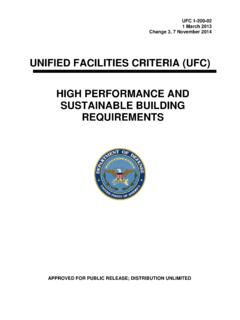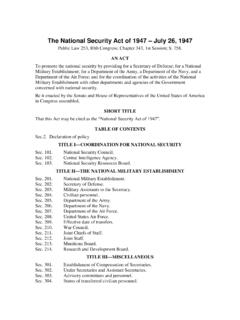Transcription of Department of Defense INSTRUCTION - Under Secretary of ...
1 Department of Defense INSTRUCTION NUMBER January 7, 2015 USD(AT&L) SUBJECT: Operation of the Defense Acquisition System References: See References 1. PURPOSE. This INSTRUCTION : a. In accordance with the authority in DoD Directive (Reference (a)), reissues the interim DoD INSTRUCTION (Reference (b)) to update established policy for the management of all acquisition programs in accordance with Reference (a), the guidelines of Office of Management and Budget Circular A-11 (Reference (c)), and References (d) through (ce). b. Authorizes Milestone Decision Authorities (MDAs) to tailor the regulatory requirements and acquisition procedures in this INSTRUCTION to more efficiently achieve program objectives, consistent with statutory requirements and Reference (a). 2. APPLICABILITY. This INSTRUCTION applies to OSD, the Military Departments, the Office of the Chairman of the Joint Chiefs of Staff and the Joint Staff, the Combatant Commands, the Office of the Inspector General of the Department of Defense , the Defense Agencies, the DoD Field Activities, and all other organizational entities within the DoD (referred to collectively in this INSTRUCTION as the DoD Components ).
2 3. POLICY. The overarching management principles and mandatory policies that govern the Defense Acquisition System are described in Reference (a). This INSTRUCTION provides the detailed procedures that guide the operation of the system. 4. RESPONSIBILITIES a. Defense Acquisition Executive (DAE). The DAE is the Under Secretary of Defense for Acquisition, Technology, and Logistics (USD(AT&L)). The DAE will act as the MDA for Major Defense Acquisition Programs (MDAPs) and Major Automated Information System (MAIS) programs. In accordance with Table 1 in Enclosure 1 of this INSTRUCTION , the DAE may DoDI , January 7, 2015 2 delegate authority to act as the MDA to the head of a DoD Component, who may further delegate the authority to the Component Acquisition Executive (CAE). The DAE may also delegate MDA authority to another OSD official as the DAE considers appropriate. b. MDA. The MDA will establish procedures for assigned programs using this INSTRUCTION as guidance.
3 MDAs should limit mandatory procedures applicable to all assigned programs so as to not exceed the requirements for MDAPs or MAIS programs and other acquisition programs governed by this INSTRUCTION or DoD Directive (Reference (a)). MDAs should tailor regulatory procedures in the document consistent with sound business practice and the risks associated with the product being acquired. c. Heads of the DoD Components. The DoD Component Head will implement the procedures in this INSTRUCTION and Reference (a). Component-required procedures will not exceed those specified in this INSTRUCTION . When necessary, waivers or requests for exceptions to the provisions of this INSTRUCTION will be submitted to the DAE, the DoD Chief Information Officer, the Director, Operational Test and Evaluation (DOT&E), or the Director, Cost Assessment and Program Evaluation (DCAPE), via the CAE. Statutory requirements cannot be waived unless the statute permits. 5. PROCEDURES a. Overview (1) The statutes governing Defense acquisition programs are complex, and the categories into which a program falls will impact acquisition procedures.
4 The designation of a program as an MDAP, a MAIS program, or a Major Weapons System; and the determination that the program is an Information System, a Defense Business System, or responds to an urgent need affect program procedures and policies . (2) The structure of a DoD acquisition program and the procedures used should be tailored as much as possible to the characteristics of the product being acquired, and to the totality of circumstances associated with the program including operational urgency and risk factors. (a) MDAs will tailor program strategies and oversight, including program information, acquisition phase content, the timing and scope of decision reviews and decision levels, based on the specifics of the product being acquired, including complexity, risk factors, and required timelines to satisfy validated capability requirements. (b) When there is a strong threat-based or operationally driven need to field a capability solution in the shortest time, MDAs are authorized to implement streamlined procedures designed to accelerate acquisition system responsiveness.
5 Statutory requirements will be complied with, unless waived in accordance with relevant provisions. DoDI , January 7, 2015 3 (3) Program Acquisition Categories (ACATs) and Types. All Defense acquisition programs are designated by an ACAT ( , ACAT I through III) and type ( , MDAP, MAIS, or Major System). MDAPs are either estimated to achieve the statutorily defined MDAP cost threshold, or are designated as an MDAP by the DAE. Similarly, MAIS programs are either estimated to achieve the statutorily defined MAIS program cost threshold, or are designated a MAIS program by the DAE. MAIS programs are software intensive and typically have a lower investment level than MDAPs. A MAIS program that is estimated to attain the MDAP cost thresholds may be designated by the DAE as either an MDAP or a MAIS program. MDAP and MAIS program designations carry the greatest consequences in terms of management level, reporting requirements, and documentation and analysis to support program decisions.
6 Enclosure 1 of this INSTRUCTION identifies the information requirements associated with all standard program categories or types in tabular form. Table 1 in Enclosure 1 provides specific definitions, funding thresholds, and decision authorities. Some information systems are also designated as a National Security System or a Defense Business System. These designations are defined in statute and have procedural and policy consequences. Enclosure 11 addresses Information Technology, and Enclosure 12 describes Defense Business Systems. (4) Program Decision Reviews and Milestones. The purpose of the decision reviews embedded in the acquisition procedures described in this section is to carefully assess a program s readiness to proceed to the next acquisition phase and to make a sound investment decision committing the Department s financial resources. Consequently, reviews will be issue and data focused to facilitate an examination of relevant questions affecting the decisions Under consideration and to allow the MDA to judge whether the program is ready to proceed.
7 The following policies will guide decision reviews: (a) The MDA is the sole and final decision authority. Staff members and staff organizations support and facilitate the MDA's execution of that authority. (b) The Defense Acquisition Board (DAB) will advise the DAE on critical acquisition decisions when the DAE is the MDA. The DAE or designee will chair the DAB. An Acquisition Decision Memorandum (ADM) will document decisions resulting from reviews. Similar procedures will be established at the Component level for use by other MDAs. (c) Program Managers, Under the supervision of Program Executive Officers (PEOs) and CAEs, are expected to design acquisition programs, prepare programs for decisions, and execute approved program plans. (d) Overarching Integrated Product Teams at the DoD level, and similar organizations within the DoD Components are expected to collectively assist the MDA in making sound investment decisions for the Department , and to ensure programs are structured and resourced to succeed.
8 These organizations are not decision bodies and they and their leaders do not supplant the authority of the Program Manager, PEO, CAE, or DAE. (e) Issues should be resolved at the lowest level possible. When an issue cannot be resolved quickly at a lower level, the issue will be submitted to the MDA with complete and objective data necessary to support a decision. DoDI , January 7, 2015 4 (f) The documents prepared in support of the decision process ( , Acquisition Strategy, Systems Engineering Plan (SEP), Test and Evaluation Master Plan (TEMP), Life-Cycle Sustainment Plan (LCSP)) should generally not be prepared solely for staff review and approval, but be intended primarily for use within the program as planning and management tools that are highly specific to the program and tailored to meet program needs. (g) Review preparation will be streamlined and efficient. Staff members will be provided with the data needed to support the review, but they will also work to minimize the overhead burden placed on the DoD Components, PEOs, program managers, and their staffs.
9 B. Relationship Between Defense Acquisition, Requirements, and Budgeting Processes (1) Acquisition, requirements, and budgeting, are closely related and must operate simultaneously with full cooperation and in close coordination. Validated Capability Requirements provide the basis for defining the products that will be acquired through the acquisition system and the budgeting process determines Department priorities and resource allocations and provides the funds necessary to execute planned programs. Throughout a product s life cycle, adjustments may have to be made to keep the three processes aligned. Capability requirements may have to be adjusted to conform to technical and fiscal reality. Acquisition programs may have to adjust to changing requirements and funding availability. Budgeted funds may have to be adjusted to make programs executable or to adapt to evolving validated capability requirements and priorities. Stable capability requirements and funding are important to successful program execution.
10 Those responsible for the three processes at the DoD level and within the DoD Components must work closely together to adapt to changing circumstances as needed, and to identify and resolve issues as early as possible. (2) Capability Requirements Process (a) All acquisition programs respond to validated capability requirements. Figure 1 illustrates the interaction between the requirements process and the acquisition process. The Chairman of the Joint Chiefs of Staff, with the advice of the Joint Requirements Oversight Council (JROC), will assess and validate joint military requirements for MDAP and MAIS programs, and less-than-MDAP or MAIS programs designated either as JROC Interest or Joint Capabilities Board Interest. When JROC validation authority is delegated in accordance with the Joint Capabilities Integration and development System (JCIDS) process in Chairman of the Joint Chiefs of Staff INSTRUCTION (Reference (d)), the DoD Components will use variations of the JCIDS to validate their requirements.













